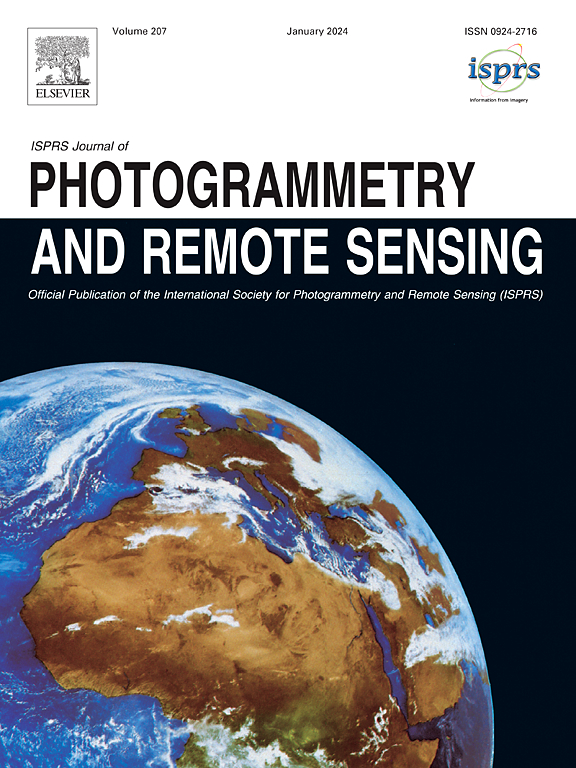跨视图地理定位与全景街景和VHR卫星图像在分散设置
IF 12.2
1区 地球科学
Q1 GEOGRAPHY, PHYSICAL
ISPRS Journal of Photogrammetry and Remote Sensing
Pub Date : 2025-06-03
DOI:10.1016/j.isprsjprs.2025.04.033
引用次数: 0
摘要
Cross-View Geo-Localization通过将街景查询图像与带有地理标记的鸟瞰参考图像进行匹配,解决了gnss拒绝环境(包括灾害响应场景、城市峡谷和茂密森林)中图像地理定位的挑战。然而,目前的研究往往依赖于假设中心对齐设置的基准和方法,或者只考虑有限的分散性,我们将其定义为查询图像相对于参考图像中心的偏移量。这样的假设无法反映现实世界的场景,因为参考数据库通常是预先建立的,无法确保每个查询图像的完美对齐。此外,分散性是值得深入研究的关键因素,因为较大的分散性可以大大提高定位效率,但代价是定位精度下降。为了解决这一限制,我们引入了分散性相关街景和卫星视图数据集DReSS (Decentrality Related Street-view and Satellite-view dataset),这是一个新的数据集,旨在评估具有大地理范围和多样化景观的跨视图地理定位,强调分散性问题。同时,我们提出了AuxGeo (Auxiliary Enhanced Geo-Localization,辅助增强地理定位)来进一步研究非中心化问题,该方法利用两个新颖模块:鸟瞰中介模块(BIM)和位置约束模块(PCM)的多度量优化策略。BIM使用街景全景图衍生的鸟瞰图作为中介,将“交叉视角挑战与分散性”简化为交叉视角问题和分散性问题。PCM利用交叉视图图像之间的位置先验来建立多粒度对齐约束。这些模块提高了定位精度,尽管存在分散性问题。大量的实验表明,AuxGeo在我们提出的DReSS数据集上优于以前的方法,减轻了大分散性的问题,并且在现有的公共数据集(如CVUSA, CVACT和VIGOR)上也达到了最先进的性能。代码和数据集将在https://github.com/SummerpanKing/DReSS上提供。本文章由计算机程序翻译,如有差异,请以英文原文为准。
Cross-view geo-localization with panoramic street-view and VHR satellite imagery in decentrality settings
Cross-View Geo-Localization tackles the challenge of image geo-localization in GNSS-denied environments, including disaster response scenarios, urban canyons, and dense forests, by matching street-view query images with geo-tagged aerial-view reference images. However, current research often relies on benchmarks and methods that assume center-aligned settings or account for only limited decentrality, which we define as the offset of the query image relative to the reference image center. Such assumptions fail to reflect real-world scenarios, where reference databases are typically pre-established without the possibility of ensuring perfect alignment for each query image. Moreover, decentrality is a critical factor warranting deeper investigation, as larger decentrality can substantially improve localization efficiency but comes at the cost of declines in localization accuracy. To address this limitation, we introduce DReSS (Decentrality Related Street-view and Satellite-view dataset), a novel dataset designed to evaluate cross-view geo-localization with a large geographic scope and diverse landscapes, emphasizing the decentrality issue. Meanwhile, we propose AuxGeo (Auxiliary Enhanced Geo-Localization) to further study the decentrality issue, which leverages a multi-metric optimization strategy with two novel modules: the Bird’s-eye view Intermediary Module (BIM) and the Position Constraint Module (PCM). BIM uses bird’s-eye view images derived from street-view panoramas as an intermediary, simplifying the “cross-view challenge with decentrality” to a cross-view problem and a decentrality problem. PCM leverages position priors between cross-view images to establish multi-grained alignment constraints. These modules improve the localization accuracy despite the decentrality problem. Extensive experiments demonstrate that AuxGeo outperforms previous methods on our proposed DReSS dataset, mitigating the issue of large decentrality, and also achieves state-of-the-art performance on existing public datasets such as CVUSA, CVACT, and VIGOR. The codes and dataset will be made available at https://github.com/SummerpanKing/DReSS.
求助全文
通过发布文献求助,成功后即可免费获取论文全文。
去求助
来源期刊

ISPRS Journal of Photogrammetry and Remote Sensing
工程技术-成像科学与照相技术
CiteScore
21.00
自引率
6.30%
发文量
273
审稿时长
40 days
期刊介绍:
The ISPRS Journal of Photogrammetry and Remote Sensing (P&RS) serves as the official journal of the International Society for Photogrammetry and Remote Sensing (ISPRS). It acts as a platform for scientists and professionals worldwide who are involved in various disciplines that utilize photogrammetry, remote sensing, spatial information systems, computer vision, and related fields. The journal aims to facilitate communication and dissemination of advancements in these disciplines, while also acting as a comprehensive source of reference and archive.
P&RS endeavors to publish high-quality, peer-reviewed research papers that are preferably original and have not been published before. These papers can cover scientific/research, technological development, or application/practical aspects. Additionally, the journal welcomes papers that are based on presentations from ISPRS meetings, as long as they are considered significant contributions to the aforementioned fields.
In particular, P&RS encourages the submission of papers that are of broad scientific interest, showcase innovative applications (especially in emerging fields), have an interdisciplinary focus, discuss topics that have received limited attention in P&RS or related journals, or explore new directions in scientific or professional realms. It is preferred that theoretical papers include practical applications, while papers focusing on systems and applications should include a theoretical background.
 求助内容:
求助内容: 应助结果提醒方式:
应助结果提醒方式:


